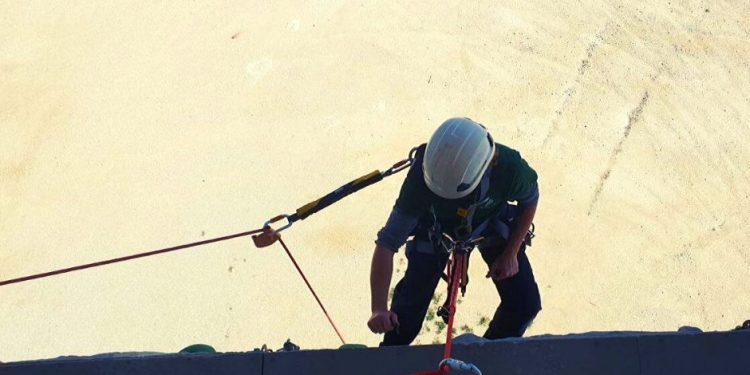The challenges over the years have changed in each association, but they all agree that there is still much to do. “In 1995, rope access work was not regulated and was therefore prohibited in reunified Germany, while in the GDR, former East Germany, it was allowed,” says Sven Drangeid. The main problem is that some institutions and rope access companies believed that rope access work is the use of PPE against falls from a height, and we are still persuading and clarifying that this is a misconception.”
Drangeid’s assessment shows that the media, for example, still does not show a real picture of vertical work. “The situation has improved in the course of these twenty-five years, but there is still a lot of work to do. Rope access is exaggerated in the media, and unfortunately, the image we have is that of some reckless people doing hard and dangerous work – he complains -. We are convinced that vertical work is safe. The technicians are highly trained, and especially the supervisors are very involved in the subjects of Safety and Health at Work. Rope access operations are carried out effectively and with an extraordinarily high level of security”.
Similarly, Floriane Forgot comes from France. “Our main challenge was to make our profession known and recognized. Now we work mainly in the security and the qualification of the technicians”. Today the vertical work activity is recognized in France as a profession in its own right. “Both the teams and the jobs have evolved considerably; we only have a distant connection with sports practices,” he describes. Our profession is legally recognized but with limitations. The vertical works are only authorized when the use of other techniques, such as scaffolding or gondolas, are impossible or riskier”.
Interestingly, in Norway and Germany, it also happens more or less in a similar way. “In our regulations, vertical work is the ultimate solution for work at height, as is protection against falls. Therefore, there is a way to go. In general, there is still some skepticism around rope access,” says Tore Rønstad, SOFT secretary.
“We still have some pending challenges in Germany. In general, our technicians and operating companies do not have any problems when it comes to requesting permission or working with ropes,” explains Sven Drangeid, FISAT manager. But we have to face reality and assess whether rope access is the best way to get a job done before an offer is made or equipment shipped. If the job is spread over time, it may make more sense to put up scaffolding. Although in this case, the scaffolding assembly and disassembly times must also be taken into account”.
Rønstad introduces another task yet to be developed: diversification. “We have too much weight from offshore oil and gas platforms. Our members are very dependent on this market. So our biggest challenge is to establish and understand rope access in the onshore market”.
Legislation that can still be improved
The large pending account of the regulations applicable to vertical work is summarized by Sven Drangeid, manager of the German association. “We hope that the phrase ‘rope access and positioning techniques can only be used […] when the use of other safer work equipment is not justified’ will be dropped at the European level shortly.”
Still, overall, FISAC is satisfied with the German regulations. “We are part of several official working groups, and we are satisfied with the existing rules and regulations. The latest post is on Rope Access Technician Assessment Requirements. The main focus is the completely independent certification process of the training, the way that FISAT and most of the established rope access associations handle their evaluations for decades”.
However,
Tore Rønstad, from Norway, believes that there is still a long way to go in his country. “Vertical work is becoming more and more accepted, albeit slowly. The existing regulation is still far from what we think it should be,” he says. SOFT plays a fundamental role in this regard, as Rønstad points out: “We are participating in standardization work in constant contact with the authorities. We also participate in other forums so that work at height is increasingly safe”.
It coincides with the role of SFETH in France. “Our Union is committed to elabo
to provide technical recommendations, to participate in standardization work, to improve safety standards, and to train and qualify staff”, says Floriane Forgot. Also, with the work of FISAT in Germany. “We also try to be present at fairs and exhibitions – adds Sven Drangeid – and represent the vertical work industry as efficient, responsible, and safe.”
Drangeid affirms it emphatically. However, the details are the main achievement of the association’s legislation on safety in vertical work: “Our safety guidelines for vertical work have been the basis of the “Technical standards for safety at work. Vertical jobs »that the Government has assumed. Training and evaluation standards are high, and our manual is the first publication to cover all the necessary techniques in detail. This has been a huge project, but it has been worth every minute and every euro that we have invested. And they have been a lot of both”.
The certification is also currently in France. “The SFETH has registered a subsidiary association called DPMC (Development and Promotion of Trade in Access Through Ropes) to develop and manage the certification of the skills of rope access workers,” explains Floriane Forgot, who represents the association in all its Projects. And he adds: “To guarantee the impartiality of the evaluations, the DPMC has been dedicated solely to certification and no longer to training since 2002. It recruits and trains the members of the jury, organizes examination sessions and transmits the certificates of certification to a national and public body, the CPNE, which issues diplomas”.
Challenges of the future: evolution and recognition
In each country, however, the looming challenges of vertical activity are very different, although there are also some overlaps. Sven Drangeid, from Germany, assesses the immediate future: “Wind energy is a huge industry with more turbines to come, especially in offshore wind farms. We are optimistic that there will be an increase in demand. But there are some challenges that we have to face, as offshore is relatively new in Germany. Having no oil or gas, there is not much experience working at sea. The availability of helicopters and rescue services must be developed and procedures for working on the water. In the future we will see many rope access supervisors in the Occupational Safety and Health departments, which is a great opportunity for our trade and of course for the respective individuals”.
Forgeot insists that in France, the way forward is to get more and more recognition: “Our profession is constantly evolving, we support our members in their professional development. We represent the profession before the public powers and make our voice heard for its evolution and recognition”.
From SOFT, the balance is directed more to the dismissal and the legislative improvement. “In Norway, we have a national standard for rope access. It contains an outline of competence, requirements for the job, the composition of the team, level of competence, requirements for the supplier companies”, she lists. “The current situation of vertical work is developing in a positive direction, but we see that abroad it is completely accepted, and here there is still something to be done.” For this reason, Tore Rønstad highlights the need for dialogue and support among other national associations. “From our point of view, the other associations have experience in other areas of work than us. From this, we can learn. It would also be nice to do it from the statistics and from the lessons that other associations (incidents/accidents) have already assumed”.
An inalienable dialogue
Floriane Forgot, SFETH general secretary, precisely, also insists on SOFT’s vision: “Today we are mainly interested in observing other forms implemented by similar associations.” This is also what Sven Drangeid from Germany points out: “Being a member of ECRA is a great benefit. Being able to pick up the phone and call a colleague from France, Spain, or Norway to ask for another opinion is priceless. We are grateful for the exchange and communication with each of the associations willing to share thoughts and ideas”.
Tore Rønstad, Technical Director of SOFT, also adds: “It is important for us to be in contact with other associations. We learn a lot. Rope access is largely a small industry. And we believe that bad practices in other countries also affect us. Therefore, we have to cooperate on a quality and safety level to ensure that the accident rate remains low. An example is that there are concerns around an American association”.
Vertical jobs are dangerous
If there is one issue on which there seems to be unanimity among the uninitiated to vertical work, it is this: we risk our lives, and only luck or chance makes us return home safe and sound every day. Or something like that.
Let’s clarify one thing: vertical work is a completely different activity from mountain activities such as climbing, mountaineering or caving.
The level of security with which we work in the vertical sector is objectively higher than that of the activities as mentioned above. The use of a double lanyard is perhaps the most visible distinguishing feature.
Of course, the danger exists, yes, but the risk assumed is low. Let’s see why. First of all, we must differentiate between danger and risk:
Danger: potential source or situation of damage in terms of injury or negative effects on human health.
Risk: combination of the probability and the consequence (s) resulting from the occurrence of a specified hazardous event.
Hazards are identified, risks are assessed. If we talk about vertical work, we can affirm that the danger is high. In most cases, a fall is synonymous with death.















